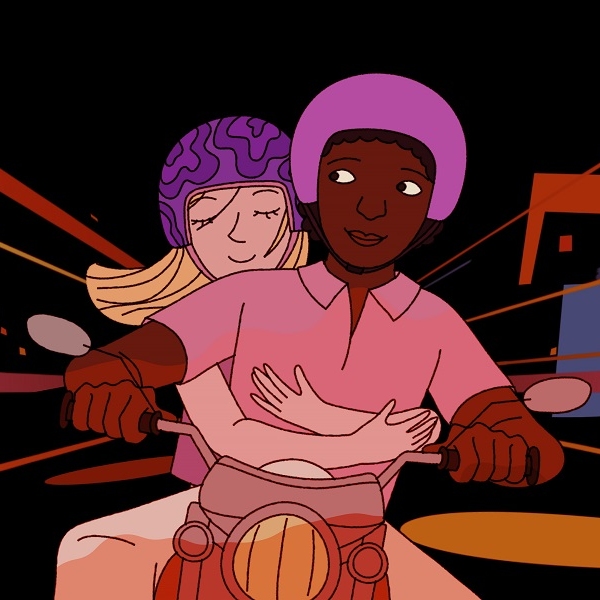When Jaime Weinman, BA’98, makes a bold statement, he goes for broke.
In the foreword to his new book Anvils, Mallets & Dynamite: The Unauthorized Biography of Looney Tunes, he writes, “There are some things I love that I don’t think are that great, and others that I know are an acquired taste. Looney Tunes is different. To me, it is the greatest achievement of American film comedy in the sound era.”
Read that again: “The greatest achievement of American film comedy in the sound era.” About cartoons? Yes, cartoons, and specifically the output of the Warner Brothers animation division from its beginnings in the 1930s, through its heyday in the immediate postwar years.
Directed by legendary figures like Tex Avery, Friz Freleng, Chuck Jones, and Bob Clampett, these animated shorts were beautifully crafted, sharp-witted, and edgier in tone than the works produced by their arch-rivals at Disney. Between 1944 and 1958, the cartoons received 16 Academy Award nominations, and picked up five Oscars. Works like One Froggy Evening and What’s Opera, Doc? are regarded as all-time classics.
Bugs Bunny, Daffy Duck, Elmer Fudd and their friends are still familiar characters today – they recently starred alongside basketball superstar LeBron James in Space Jam: A New Legacy, and the Emmy-nominated Looney Tunes Cartoons, which premiered in 2020, is available on HBO Max.
Weinman, who writes about popular culture for Maclean’s, Vox, Vice, and other publications, recently spoke to the McGill News about his book.
How did you come to love the Warner Brothers cartoon characters so much that you wanted to write their unauthorized autobiography?
Like many people, I grew up watching the cartoons on TV and laughing at them. But I think the catalyst for my obsession with them was simply renting some videos back when that was a thing, after I’d gotten older.
I realized that, unlike most of the cartoons I’d watched when I was a child, which I had come to [realize] were not very good, the Warner Brothers cartoons were actually better than I had thought. They held up even better than I could have imagined. Normally you have to accept that things you loved when you were a child were not that great.
I wanted to learn more about the people who had managed to make these cartoons that stood the test of time, in ways they could not have imagined.
You cover the four great animation directors at Warner Brothers: Tex Avery, Chuck Jones, Friz Freleng and Bob Clampett. Unlike at other studios like Disney, they had an enormous amount of creative freedom. How did that system come about, and how did it work?
As I explain in the book, Leon Schlesinger was the producer of Looney Tunes and Merrie Melodies until Warner Brothers bought him out in the 1940s. At first, he was independent, and Warner Brothers only distributed [the cartoons].
Schlesinger had no animation background, he got into cartoons and live-action B-movies because he had specialized in making title cards for silent movies, and he needed to get into something new fast once talkies came in. So, he got into animation with some ex-Disney people named Hugh Harmon and Rudy Isaac. But they left, and they took their characters with them, and left Schlesinger with no experienced directors and no star character. That created kind of a power vacuum that strong directors like Friz Freleng and Tex Avery could fill.
So, Schlesinger let them do their own things?
Yes. Schlesinger was a hands-off producer. He did not pretend to be like Walt Disney, or someone who had very strong ideas about what good cartooning should be. That gave the director a lot of freedom simply because there was no one telling him anything except, “Bring it in on time and on budget, and make it funny.”
Work that would normally have been done by a producer, fell to the director by default at Warner Brothers. They were the de facto producers of their own work. Not all of [the directors] liked Schlesinger, but most of them came to appreciate the fact that he left them alone and free within those limits.
In the book you discuss one of the perennial questions about Warner Brothers cartoons, their violence, especially when compared to the other studios. You even called some of the characters “funny sociopaths.” How did Warner end up with that formula?
It’s bits and pieces of a lot of different influences. Certainly, a lot of silent movies have a lot of violence in them, and early cartoons of the sound era, including Disney’s, can be rough in terms of the amount of pain characters are submitted to.
But the Warner Brother animators just found that violence was getting the best laughs, and when something gets laughs, you want to do more of it, and then more, you want to top yourself. The cartoons that hit it big with Daffy Duck and Bugs Bunny were hunting cartoons, where someone with a gun goes out and tries to shoot an animal, and they turn the tables on them. And so that means the threat of violence is omnipresent. I also speculate that the war may have had something to do with it.
You also discussed the “censored eleven,” the cartoons that are just not showable today because of their racist content.
It used to be more than 11. In the late 1960s, the owner of the pre-1948 package of Warner cartoons took a look at complaints they’d gotten about racist content, and they identified 11 cartoons where negative racial stereotypes were so much a part of the story that they were impossible to edit.
Coal Black and the Seven Dwarfs, which I cover a lot in the book, is the most famous of them, and also the best just in terms of its craftsmanship. I’m using the term “best” not in a moral sense, of course. So those 11 cartoons were too racist to show on TV in the 1960s, and as time went on, more cartoons started to get pulled, including one where Bugs Bunny fights the Japanese during World War Two, called Bugs Bunny Nips the Nips.
You also discuss multiple contemporary attempts at reviving the Warner Brothers characters, including the Space Jam movies, and more recent TV series, like Wabbit. Is it accurate to say that you don’t think they were entirely successful?
I don’t think any of them have been totally successful. I think it’s very difficult to revive these characters who were only meant for one specific type of cartoon that doesn’t exist anymore: the seven-minute theatrical cartoon that plays before a movie.
All the [recent] attempts at reviving the characters have been trying to find a new format that works for them. [The] style that came very easy to the directors of the day does not come naturally to us. It was based on instinct. They poured all of their influences into their work, but we have the disadvantage of living in a world where those cartoons already exist.
You say in the book that the WB cartoons violated almost all of the rules of traditional storytelling. The good guys aren’t always sympathetic, the bad guys are usually not competent, the stories don’t really have traditional beginnings, middles or ends…
The only rule is, what’s funny works, and what isn’t funny, doesn’t. A lot of things [were created] in these cartoons on a very instinctive level, because there’s not enough time to tell an elaborate story with a beginning, middle and end. And there aren’t any realistic guidelines for how a talking rabbit the size of a human can interact with people. And I think a lot of what we saw in those WB cartoons was simply this instinctive process, almost like musical composition.


